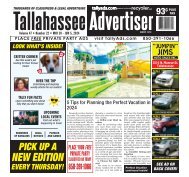TLA37_AllPages
You also want an ePaper? Increase the reach of your titles
YUMPU automatically turns print PDFs into web optimized ePapers that Google loves.
Cultural<br />
Change<br />
DE-<br />
Efforts to reduce turnover must start at the top<br />
and permeate every layer of management<br />
By Cliff Abbott<br />
How do some carriers achieve such low turnerover rates? It starts with<br />
a plan, and that plan “starts with the acknowledgement that turnover is<br />
man-made and not inevitable,” says past TCA Chairman and current TCA<br />
Profitability Program (TPP) Retention Coach Ray Haight.<br />
“One of the things that always gets me is when I attend a conference<br />
where someone says, ‘this or that organization reports turnover at over 100%,<br />
but we’re only at 80% so we’re doing good.’ My advice is, don’t worry about<br />
the industry. What can you do?”<br />
Haight doesn’t just talk trucking, he’s experienced it on many levels. He<br />
knows the ins and outs of making a living on the road, having racked up more<br />
than a million accident-free miles as a company driver and owner-operator.<br />
In 1984, he started Southwestern Express in London, Ontario, growing the<br />
company to 50 tractors before entering a 1990 partnership with Guelph,<br />
Ontario-based MacKinnon Transport. The two companies were completely<br />
merged in 2000, with Haight serving as president and COO.<br />
Prior to the merger, he said, turnover at Southwestern was very low.<br />
Nondriver staffing was minimal and everyone knew everyone else. After the<br />
merger, the retention dynamic began to change. Turnover rose to 120% and<br />
Haight knew something had to be done, and that meant a culture change.<br />
That culture change resulted in turnover rates dropping by more than<br />
83%, in addition to other benefits.<br />
“The point is, we didn’t just reduce driver turnover from 120% to 20%<br />
in two years,” Haight said, “we doubled operating margins. We drastically<br />
improved our safety record. We impacted nearly every KPI that owners and<br />
CEOs track to determine the success of their organizations.”<br />
Those are the rewards Haight wants every carrier to realize.<br />
“Do the math,” he said. “At 120% turnover, we were hiring 300 drivers a<br />
year just to stay the same size. At a rate of about $6,000 per hire to recruit<br />
and train each new driver, that’s $1.8 million that didn’t need to be spent.”<br />
In his role as TPP retention coach, Haight teaches his retention program to<br />
carriers all over North America, and he commands attention.<br />
“It bothers me when companies delegate retention to a ‘retention coach’ or<br />
‘retention manager,’” he said. “Solving the turnover problem requires a culture<br />
change. That starts at the top and permeates every layer of management in<br />
the organization.”<br />
The people at the top, however, often aren’t the ones in attendance at<br />
the retention programs he presents at TCA and at other events. “Who goes<br />
to these things?” he asks. “It’s recruiting and safety managers. The ‘C-level’<br />
people aren’t there.” That adds more steps to the solution, Haight said. “In<br />
addition to learning the material, they have to go back and convince C-level<br />
leaders to take the necessary steps.”<br />
When Haight makes the presentation directly to a carrier, he’s adamant<br />
about making sure the program will be supported from the top. “When I’m<br />
asked to help out at a company I don’t even do these programs unless I can<br />
talk to the owner or CEO,” he said. “Culture change isn’t possible without<br />
C-level buy-in.”<br />
A part of his reasoning comes down to trust, and he thinks some carriers<br />
overestimate the trust drivers have in their leadership. Trust is related to<br />
turnover, he said. “The higher your turnover rate, the less likely the team is to<br />
believe what you’re saying.”<br />
Haight’s retention program is based on a psychology theory first proposed<br />
in 1943 by Abraham Maslow in “Psychological Review” and more fully fleshed<br />
out in his 1954 book, “Motivation and Personality.” Maslow’s theory is that<br />
the needs of an individual start with basic physiological needs and progress<br />
through several stages, including safety, love/belonging, esteem and selfactualization.<br />
The “Maslow’s Hierarchy of Needs” diagram, a pyramid with the<br />
most basic needs at the base and more complex needs near the top, is a staple<br />
of many management classes.<br />
Haight relates each level of the pyramid to the driver hiring experience. He<br />
begins with a groundwork session, obtaining a commitment to change before<br />
teaching how turnover is accurately measured and guiding participants<br />
through a SWOT Analysis process. SWOT stands for Strengths, Weaknesses,<br />
Opportunities and Threats.<br />
In each of the next six sessions, he zeroes in on each level of Maslow’s<br />
hierarchy, discussing the carrier’s need for drivers and where they come<br />
from, improvements in standard operating procedures and just do its, hiring<br />
policies and performance management.<br />
He discusses how to address the social needs of employees, including<br />
establishment of a communication action team and a recruitment and<br />
retention action team. Haight points out that there are more options for<br />
communicating with drivers and their families than ever before, and points<br />
to social media as a great tool.<br />
“Carriers like Bison and Nussbaum have really figured out how to use<br />
social media,” he said. “They use video so much, they even have bloopers and<br />
outtakes from some of their videos that drivers find very entertaining.”<br />
Communication comes in many forms, however, and isn’t always as<br />
complicated as recording videos or handling social media platforms. “If your<br />
trucks, terminals and offices look like they aren’t well cared for, it gives the<br />
impression that your company is not well-run,” he said.<br />
Communication also involves sharing information that isn’t necessarily<br />
related to job tasks, such as industry news. Haight pointed out that any news<br />
worth sharing around the office is worth sharing with drivers, too.<br />
“It’s fairly arrogant that we get information on our desks that we study and<br />
share with other managers and never think to share with our drivers,” he said.<br />
36 TRUCKLOAD AUTHORITY | www.Truckload.org TCA 2019

















